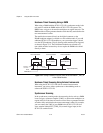Chapter 2 Using the SCXI-1127/1128
© National Instruments Corporation 2-19 SCXI-1127/1128 User Manual
NI-DAQ, use the
Thermistor_Convert
function. The VI takes the output
voltage of the temperature sensor, the reference voltage, and the precision
resistance and returns the thermistor temperature.
Alternatively, you can use the following formulas:
T(°C) = T
K
– 273.15
where T
K
is the temperature in Kelvin,
where a = 1.295361 × 10
–3
b = 2.343159 × 10
–4
c = 1.018703 × 10
–7
R
T
= resistance of the thermistor in ohms,
where V
TEMPOUT
is the output voltage of the temperature sensor,
where T(°F) and T(°C) are the temperature readings in degrees Fahrenheit
and degrees Celsius, respectively.
Making RTD Measurements
Figure 2-16 shows an RTD (R
1
) connected to channel 12 on the SCXI-1331
terminal block. The RTD is connected in the 4-wire configuration. It is
recommended that you connect RTDs in a 4-wire configuration to
eliminate the effects of lead resistance on the measurement. See the 4-Wire
versus 2-Wire Resistance Measurement section for more information.
Making Thermistor Measurements
Figure 2-16 shows a thermistor (R
2
) connected to channel 24 on the
SCXI-1331 terminal block. The thermistor is connected in the 2-wire
configuration. You can connect the thermistor in the two, four, or even
1-wire input configurations. The choice is typically dictated by channel
cost and required accuracy. The 4-wire configuration is ideal and provides
T
K
1
ab R
T
ln()cR
T
ln()
3
++[]
--------------------------------------------------------------=
R
T
189 000
V
TEMPOUT
2.5 V
TEMPOUT
–
--------------------------------------
,=
T °F()
[T(°C )]9
5
----------------------- 3 2+=


















